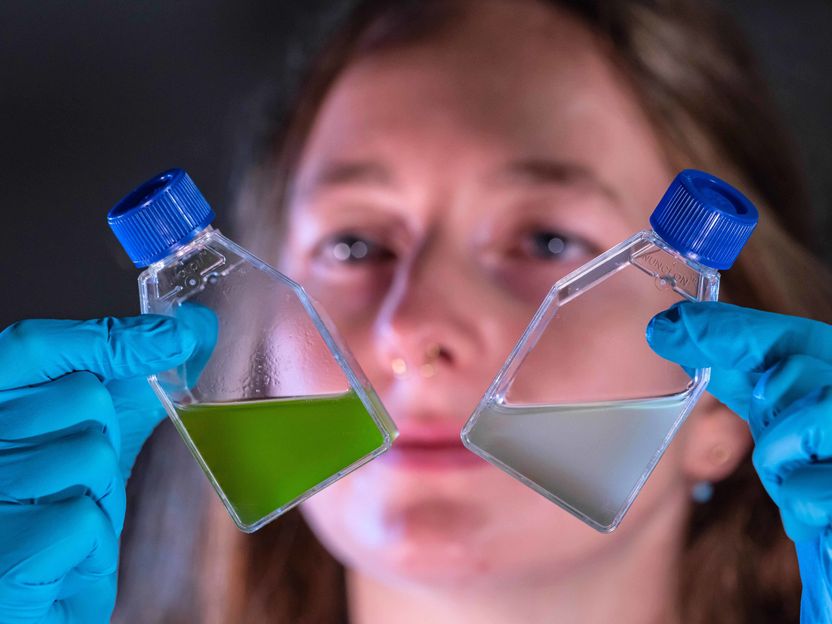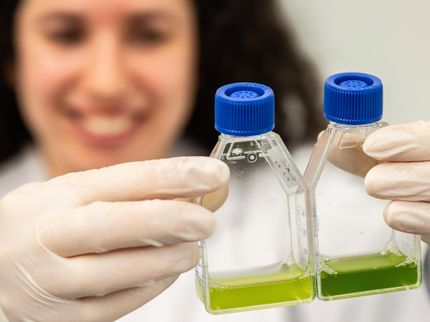Bacterial toxin blinds algae
Chemical “fingerprints” reveal the “murder weapon”
University of Jena researchers have discovered a bacterial toxin that destroys the colour pigments in the eyespot of the single-cell green alga Chlamydomonas reinhardtii. Together with another toxic substance, the bacteria of the species Pseudomonas protegens not only disorientate and immobilise the green algae, but condemn them to a certain death. The researchers detected the toxin, called “protegencin”, with the help of Raman spectroscopy and natural product research.

Green algae almost completely lose their colour when the deadly bacteria have been added to them.
Jens Meyer / Uni Jena
The researchers led by the professor for General Botany of the University of Jena, Maria Mittag, already knew from earlier studies that an encounter with Pseudomonas protegens bacteria did not do the green algae Chlamydomonas reinhardtii any good at all. Now the deadly toxin has been identified by Prof. Mittag and doctoral candidate Vivien Hotter, together with the teams led by Prof. Jürgen Popp (Institute for Physical Chemistry of the University of Jena and Leibniz Institute of Photonic Technology) and Prof. Christian Hertweck (Institute of Microbiology of the University of Jena and Leibniz Institute for Natural Product Research and Infection Biology – Hans Knöll Institute), as well as Prof. Severin Sasso (Leipzig University).
“The green algae have a primitive eye, called the eyespot, with which they perceive light and can orientate themselves,” explains Maria Mittag. This enables the single-cell organisms, measuring around 10 micrometres, to move towards the light, in order to have optimum conditions for photosynthesis. The eyespot contains two layers of yellowish carotenoid-rich fat droplets.
“The eyespot carotenoids can be studied by using Raman spectroscopy,” adds Prof. Mittag. This method analyses the scattering of laser light on molecules and provides a characteristic spectrum, comparable to a spectroscopic “fingerprint”.
Chemical “fingerprints” reveal the “murder weapon”
With this instrument, the researchers, together with Prof. Popp’s team, set about their detective work and analysed the “Raman fingerprints” from algal cultures to which Pseudomonas bacteria had been added.
“You can see the effect just with the naked eye,” reports Vivien Hotter. The green algal culture loses its colour almost completely overnight. “In parallel, the Raman signal for the eyespot carotenoids decreases.” This suggests that the algae lose their ability to orientate themselves in light, says Vivien Hotter. But that is not all: “We were also able to show that the toxin dissolves their cell membrane. The algae don’t survive that.”
The researchers, in cooperation with their colleagues in the “ChemBioSys” Collaborative Research Centre, tracked down the “murder weapon” that enables the bacteria to kill the algae. The analysis of the Raman spectra showed that not only does the signal for the eyespot pigments decrease in the course of the bacterial attack, but that a new signal not previously present also appears in the spectrum. Prof. Hertweck’s team of natural product researchers used this signal to decipher the basic chemical structure of the bacterial toxin. Together with the other researchers, they ultimately succeeded in identifying the substance “protegencin” as the cause of death.
With their basic research, the scientists in “ChemBioSys” are looking for natural substances that influence the interaction between biosystems such as microalgae and bacteria, with the aim of clarifying the underlying control mechanisms. Although microalgae contribute significantly to global oxygen production and, together with cyanobacteria, fix around 50 percent of the greenhouse gas carbon dioxide, the fundamental control mechanisms in the complex biosystems of algae and bacteria are not yet sufficiently well understood.
Original publication
Other news from the department science
Most read news
More news from our other portals
See the theme worlds for related content
Topic World Spectroscopy
Investigation with spectroscopy gives us unique insights into the composition and structure of materials. From UV-Vis spectroscopy to infrared and Raman spectroscopy to fluorescence and atomic absorption spectroscopy, spectroscopy offers us a wide range of analytical techniques to precisely characterize substances. Immerse yourself in the fascinating world of spectroscopy!

Topic World Spectroscopy
Investigation with spectroscopy gives us unique insights into the composition and structure of materials. From UV-Vis spectroscopy to infrared and Raman spectroscopy to fluorescence and atomic absorption spectroscopy, spectroscopy offers us a wide range of analytical techniques to precisely characterize substances. Immerse yourself in the fascinating world of spectroscopy!




















































